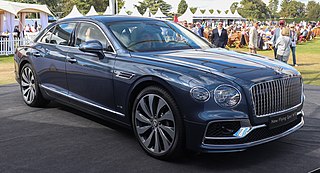
Bentley Motors Limited is a British manufacturer and marketer of luxury cars and SUVs, and a subsidiary of the Volkswagen Group since 1998.

Elliott William Barnes Sadler is an American former professional stock car racing driver. He last competed part-time in the NASCAR Xfinity Series, driving the No. 10 Chevrolet Camaro for Kaulig Racing. Sadler is one of 36 drivers who have at least one win in each of NASCAR's top three series. Sadler was born in Emporia, Virginia; he is the younger brother of former NASCAR driver Hermie Sadler.
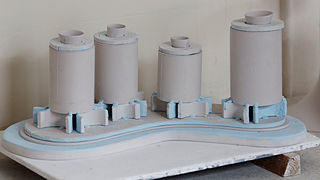
Slip casting, or slipcasting, is a ceramic forming technique for pottery and other ceramics, especially for shapes not easily made on a wheel. In this method, a liquid clay body slip is poured into plaster moulds and allowed to form a layer, the cast, on the inside walls of the mould. The process usually takes at least 24 hours per piece. It gives very precise and consistent shapes, and is now the most common technique used for commercial mass-produced pottery, although it began as a technique for fine pottery such as European porcelain in the 1750s, and Chinese Jingdezhen porcelain considerably earlier.
Mabel Lucie Attwell was a British illustrator and comics artist. She was known for her cute, nostalgic drawings of children, based on her daughter, Peggy. Her drawings are featured on many postcards, advertisements, posters, books and figurines.

Transfer printing is a method of decorating pottery or other materials using an engraved copper or steel plate from which a monochrome print on paper is taken which is then transferred by pressing onto the ceramic piece. Pottery decorated using the technique is known as transferware or transfer ware.
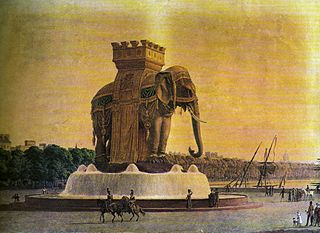
Novelty architecture, also called programmatic or mimetic architecture, is a type of architecture in which buildings and other structures are given unusual shapes for purposes such as advertising or to copy other famous buildings without any intention of being authentic. Their size and novelty means that they often serve as landmarks. They are distinct from architectural follies, in that novelty architecture is essentially usable buildings in eccentric form whereas follies are non-usable, ornamental buildings often in eccentric form.

Tickford is an automobile engineering and testing business in Newport Pagnell, Buckinghamshire, known for tuning and such products as the 140 mph Tickford Turbo Capri.

Royal Doulton is an English ceramic and home accessories manufacturer that was founded in 1815. Operating originally in Vauxhall, London, and later moving to Lambeth, in 1882 it opened a factory in Burslem, Stoke-on-Trent, in the centre of English pottery. From the start, the backbone of the business was a wide range of utilitarian wares, mostly stonewares, including storage jars, tankards and the like, and later extending to pipes for drains, lavatories and other bathroom ceramics. From 1853 to 1901, its wares were marked Doulton & Co., then from 1901, when a royal warrant was given, Royal Doulton.

Churchill China PLC is a British pottery manufacturer based in Stoke-on-Trent in the United Kingdom.

Mintons was a major company in Staffordshire pottery, "Europe's leading ceramic factory during the Victorian era", an independent business from 1793 to 1968. It was a leader in ceramic design, working in a number of different ceramic bodies, decorative techniques, and "a glorious pot-pourri of styles - Rococo shapes with Oriental motifs, Classical shapes with Medieval designs and Art Nouveau borders were among the many wonderful concoctions". As well as pottery vessels and sculptures, the firm was a leading manufacturer of tiles and other architectural ceramics, producing work for both the Houses of Parliament and United States Capitol.

The Hall China Company was an American ceramics manufacturer located in East Liverpool, Ohio, United States, known for pioneering the single-fire glazing process. At the time of its closure, Hall China was one of two potteries under the HLC Inc. brand, the other being Homer Laughlin China. In 2020, it was announced that the Hall China facility would be shuttered by February 2021 to reduce overhead in the now Fiesta Tableware Company, as the Hall China brand itself had been sold to Steelite International earlier in the year. Hall China is still produced as a food service brand by Steelite, but no longer operates as an independent brand in retail.

Victorian majolica properly refers to two types of majolica made in the second half of the 19th century in Europe and America.
Edwin Bennett, born in Newhall, Derbyshire, was an English American pioneer of the pottery industry and art in the United States, and founder of the Edwin Bennett Pottery Company of Baltimore, Maryland. Producing a variety of wares from the everyday to the fine and artistic, his company, originally founded in the 1840s as the Edwin Bennett Queensware Manufactory, continued in operation until forced to close during the Great Depression in 1936. Examples of Edwin Bennett pottery may be found in museums across the United States, including the Maryland Historical Society, the Philadelphia Museum of Art, the Metropolitan Museum of Art, and the National Museum of American History, as well as in private collections.
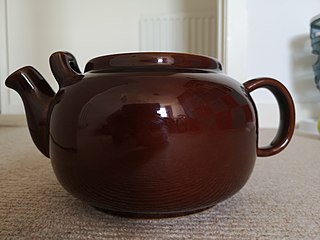
A Brown Betty is a type of teapot, round and with a manganese brown glaze known as Rockingham glaze.

Franciscan Ceramics are ceramic tableware and tile products produced by Gladding, McBean & Co. in Los Angeles, California, from 1934 to 1962, International Pipe and Ceramics (Interpace) from 1962 to 1979, and Wedgwood from 1979 to 1983. Wedgwood closed the Los Angeles plant, and moved the production of dinnerware to England in 1983. Waterford Glass Group plc purchased Wedgwood in 1986, becoming Waterford Wedgwood. KPS Capital Partners acquired all of the holdings of Waterford Wedgwood in 2009. The Franciscan brand became part of a group of companies known as WWRD, an acronym for "Wedgwood Waterford Royal Doulton." WWRD continues to produce the Franciscan patterns Desert Rose and Apple.
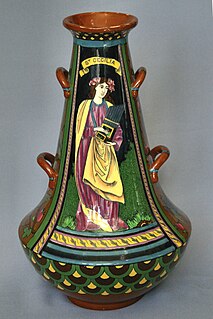
Shelley Potteries, situated in Staffordshire, was earlier known as Wileman & Co. which had also traded as The Foley Potteries. The first Shelley to join the company was Joseph Ball Shelley in 1862 and in 1896 his son Percy Shelley became the sole proprietor, after which it remained a Shelley family business until 1966 when it was taken over by Allied English Potteries. Its china and earthenware products were many and varied although the major output was table ware. In the late Victorian period the Art Nouveau style pottery and Intarsio ranges designed by art director Frederick Alfred Rhead were extremely popular but Shelley is probably best known for its fine bone china “Art Deco” ware of the inter-war years and post-war fashionable tea ware.

Redware as a single word is a term for at least two types of pottery of the last few centuries, in Europe and North America. Red ware as two words is a term used for pottery, mostly by archaeologists, found in a very wide range of places. However, these distinct usages are not always adhered to, especially when referring to the many different types of pre-colonial red wares in the Americas, which may be called "redware".

New Zealand had a long history of small garages and vehicle enthusiasts modifying and creating sports and sports racing cars. Out of these interests grew the New Zealand kit and replica car industry with the introduction of fibre-glass car bodies in the 1950s.

Roger Michell was a British studio potter, artist, illustrator, poet and writer. Although foremost a potter, his deep insight, curiosity and his singular skills enabled him to work across a range of disciplines. He was a prolific reader, often reading several books a week. His mind was constantly working on future projects, he had a vivid and complex imagination which was evident in his work. He was most known for designing Walking Ware, a tea set on legs with over-sized Mary Jane shoes. During the nineteen seventies and eighties, thousands of these tea sets were sold, either hand made from Lustre Pottery studio or manufactured by Carltonware in Stoke-on-Trent.

William George Sadler designed, built, and drove his own sports racing cars, some of which anticipated the later Formula 5000 and Can-Am cars. He left racing and earned a Masters of Electrical and Electronics Engineering, then went on to design and build light aircraft and aircraft engines, and was involved in the early development of Unmanned aerial vehicles (UAVs).



















